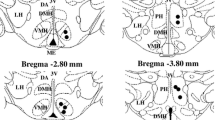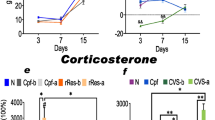Abstract
The effects of the NO donor sodium nitroprusside and the NO synthase blocker L-ω-N-nitroarginine (LNA) on body temperature, hypothalamic monoamines, and plasma corticosterone in conditions of cooling were studied in Male Wistar rats. Reductions in body temperature on cooling, both after administration of sodium nitroprusside and LNA, were no different from those seen without treatment. The basal corticosterone level after treatment with sodium nitroprusside increased from 5.3 ± 2.2 to 29.1 ± 1.8 µg%. Cooling led to a multiple increase in corticosterone levels in all animals, both in control conditions and after treatment with sodium nitroprusside and LNA. Sodium nitroprusside significantly decreased the basal hypothalamic noradrenaline level, by 37%. Cooling of the animals in these conditions led to an additional drop in the noradrenaline level. Noradrenaline levels 48 h after cold stress applied to animals cooled after treatment with LNA or sodium nitroprusside were significantly higher than in those cooled without treatment. No changes in serotonin and 5-hydroxyindoleacetic acid levels were seen in these experiments. The basal dihydroxyphenylacetic acid and dopamine levels increased after treatment with sodium nitroprusside, by 379% and 239% respectively. No dopamine response to cold was observed, though the dihydroxyphenylacetic acid level in the control group and animals treated with LNA increased. Thus, cold stress did not reveal differently directed directions for the actions of the NO donor and the NO synthase blocker, as seen with other types of stress.
Similar content being viewed by others

REFERENCES
N. P. Aimasheva E. B. Malenyuk E. B. Manukhina F. Viegant V. D. Mikoyan L. N. Kubrina A. F. Vanin I. Y. Malyshev (1998) ArticleTitleThe antistress effect of adaptation to physical loading: the role of nitric oxide Dokl. Ross. Akad. Nauk 362 IssueID2 421–423
E. B. Malenyuk N. P. Aimasheva E. B. Manukhina V. D. Mikoyan L. N. Kubrina A. F. Vanin N. P. Larionov I. Y. Malyshev (1998) ArticleTitleIs nitric oxide involved in the adaptive defense of the body against stress damage? Byull. Éksperim. Biol. Med. 126 IssueID9 274–277
E. B. Manukhina I. Y. Malyshev (2000) ArticleTitleThe nitric oxide stress-limiting system Ros. Fiziol. Zh. im. I. M. Sechenova 86 IssueID10 1283–1292
S. Y. Mashina B. V. Smirin I. Y. Malyshev N. P. Lyamina V. N. Senchikhin D. A. Pokidyshev E. B. Manukhina (2001) ArticleTitleCorrection of NO-dependent cardiovascular lesions by adaptation to hypoxia Ros. Fiziol. Zh. im. I. M. Sechenova 87 IssueID1 110–117
A. A. Tinnikov N. M. Bazhan (1984) ArticleTitleMeasurement of glucocorticoids in plasma and incubation medium by competitive protein binding without prior extraction Lab. Delo 12 709–713
K. Addicks W. Bloch M. Feelisch (1994) ArticleTitleNitric oxide modulates sympathetic neurotransmission at the prejunctional level Microsci. Res. Tech. 29 161–168
J. Bugajski J. Borycz A. Gadek-Michalska R. Glod (1998) ArticleTitleEffect of L-NAME, a specific nitric oxide synthase inhibitor, on corticotropin releasing hormone-elicited ACTH and corticosterone secretion J. Physiol. Pharmacol. 49 IssueID4 607–616
B. Luca ParticleDe M. Monda A. Sullo (1995) ArticleTitleChanges in eating behavior and thermogenic activity following inhibition of nitric oxide formation Amer. J. Physiol. 268 IssueID6 R1533–R1538
A. J. Dunn (1998) ArticleTitleBrain catecholaminergic and tryptophan responses to restraint are attenuated by nitric oxide synthase inhibition Neurochem. Int. 33 IssueID6 551–557
S. Eriksson H. Hjelmqvist R. Keil R. Gerstberger (1997) ArticleTitleCentral application of nitric oxide donor activates head defence in the rabbit Brain Res. 774 IssueID1-2 269–273
H. Hashiguchi S. H. Ye F. Ross-Cisneros N. Alexander (1997) ArticleTitleCentral nitric oxide donors attenuate cardiovascular and central norepinephrine responses to stress Amer. J. Physiol. 272 IssueID5 R1447–R1453
T. Horn P. M. Smith B. E. McLaughlin L. Bauce G. S. Marks Q. J. Pittman A. V. Ferguson (1994) ArticleTitleNitric oxide actions in paraventricular nucleus: cardiovascular and neurochemical implications Amer. J. Physiol. 266 IssueID1 R306–R313
A. Kuroshima (1995) ArticleTitleRegulation of thermoregulatory thermogenesis Hokkaido Igaku Zasshi 70 IssueID1 1–8
P. C. Mills D. J. Marlin C. M. Scott N. C. Smith (1997) ArticleTitleNitric oxide and thermoregulation during exercise in the horse J. Appl. Physiol. 82 IssueID4 1033–1034
M. Monda S. Amaro A. Sullo B. Luca ParticleDe (1994) ArticleTitleNitric oxide reduces the thermogenic changes induced by lateral hypothalamic lesion J. Physiol. (Paris) 88 IssueID6 347–352
M. L. Nurminen H. Vapaatalo (1996) ArticleTitleEffect of intracerebroventricular and intravenous administration of nitric oxide donors on blood pressure and heart rate in anaesthetized rats Brit. J. Pharmacol. 119 IssueID7 1422–1426
S. Okada Y. Murakami K. Yokotani (2002) ArticleTitleCentrally applied nitric oxide donor elevates plasma corticosterone by activation of the hypothalamic noradrenergic neurons in rats Brain Res. 939 IssueID1-2 26–33
S. K. Saha A. Kuroshima (2000) ArticleTitleNitric oxide and thermogenic function of brown adipose tissue in rats Jap. J. Physiol. 50 IssueID3 337–342
A. Selicovich M. Lasaga M. Befumo B. H. Duvilanski M. Carmen Diaz Particledel V. Retorri S. M. McCann (1995) ArticleTitleNitric oxide inhibits the release of norepinephrine and dopamine from the medial basal hypothalamus of the rat Proc. Natl. Acad. Sci. USA 92 IssueID24 1199–1302
C. Tassorelli F. Blandini A. Costa E. Preza G. Nappi (2002) ArticleTitleNitroglycerin-induced activation of monoaminergic transmission in the rat Cephalaldia 22 IssueID3 226–232
T. Tsuchiya J. Kishimoto J. Koyama T. Oxawa (1997) ArticleTitleModulatory effect of L-NAME, a specific nitric oxide synthase (NOS) inhibitor, on stress-induced changes in plasma adrenocorticotropic hormone (ACTH) and corticosterone levels in rats; physiological significance of stress-induced NOS activation in hypothalamus-pituitary-adrenal axis Brain Res. 776 IssueID1-2 68–74
J. Weidenfeld S. Feldman F. G. DeKeyser H. Ovadia (1999) ArticleTitleEffect of exogenous nitric oxide and inhibitors of nitric oxide synthase on the hypothalamus-pituitary-adrenal axis responses to neural stimuli Neuroendocrinol. 70 IssueID3 153–159
Author information
Authors and Affiliations
Additional information
Translated from Rossiiskii Fiziologicheskii Zhurnal imeni I. M. Sechenova, Vol. 89, No. 7, pp. 795–802, July, 2003.
Rights and permissions
About this article
Cite this article
Gilinskii, M.A., Petrakova, G.M., Amstislavskaya, T.G. et al. Hypothalamic monoamines in cold stress on the background of changes in the activity of the Nitric Oxide system. Neurosci Behav Physiol 35, 171–175 (2005). https://doi.org/10.1007/s11055-005-0010-8
Received:
Revised:
Issue Date:
DOI: https://doi.org/10.1007/s11055-005-0010-8



